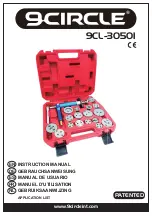
-15-
APPLICATION
Your Dremel Multi-Max™ Tool is intended for
sanding and cutting wooden materials, plastic,
plaster and non-ferrous metals. It is especially
suitable for working close to edges, in tight
spaces, and for flush cutting. This tool must be
used only with Dremel accessories .
Below are some typical uses for your Dremel
Multi-Max™ Tool.
For all accessories, work
with the accessory away
from the body.
Never position hand near or
directly in front of working area. Always hold
the tool with both hands and wear protective
gloves.
Flush Cutting
Remove excess wood from door jamb, window
sill and/or toekick. Removing excess copper or
PVC pipe.
Removal work
e.g. carpets & backing, old tile adhesives,
caulking on masonry, wood and other
surfaces.
Removal of excess materials
e.g. plaster, mortar splatters, concrete on tiles,
sills.
Preparation of surfaces
e.g. for new floors and tiles.
Detail sanding
e.g. for sanding in extremely tight areas
otherwise difficult to reach and require hand
sanding
CUTTING
Saw blades are ideal for making precise cuts
in tight areas, close to edges or flush to a
surface.
Select a medium to high speed for making
initial plunge, start off at medium speed for
increased control. After making your initial cut,
you can increase speed for faster cutting
ability.
Flush cutting blades are
intended to make precise cuts to
allow for installation of flooring or
wall material. When flush cutting
it is important not to force the tool during the
plunge cut. If you experience a strong vibration
in your hand during the plunge cut, this
indicates that you are applying too much
pressure. Back the tool out and let the speed
of the tool do the work. While keeping the teeth
of the blade in the work surface, move the
back of the tool in a slow sideways motion.
This motion will help expedite the cut.
When making a flush cut it is always a good
idea to have a piece of scrap material (tile or
wood) supporting the blade. If you need to rest
the flush cutting blade on a delicate surface,
you should protect the surface with cardboard
or masking tape.
The flat saw blade is ideal for
making precise cuts in wood,
plaster, drywall material.
Applications include cutting openings in flooring
for venting, repairing damaged flooring, cutting
openings for electrical boxes. The blade works
best on softer woods such as pine. For harder
woods, the blade life will be limited.
Select a medium to high speed.
The flat saw blade can also be used for
window restoration making glazing easy to
remove. The saw blade can be placed directly
against the edge of the window frame, guiding
the blade through the glazing.
Panel Cutting Accessory
Model VC490
The panel blade has been
designed for making straight
cuts in sheet materials, such as
plywood, drywall and cement
board up to ¾” thick. (Refer to chart for cutting
depths.) For best results, this blade should be
used with the tools control foot in the open
position. This blade has a more rigid design to
help improve accuracy and control when
making these types of cuts. When making
cuts in sheet materials it is important not to
force the tool during the cut. If you experience
strong vibration in your hand during the cut,
this indicates that you are applying too much
pressure. Back the tool out of the cut and let
the speed of the tool do the work.
Pipe and 2x4 Cutting Accessory
Model VC494
The pipe and 2x4 cutting blade
has been designed to cut
through thick materials, such as
a 2x4, as well as tubing, such as
conduit, copper and PVC piping.
Operating Applications
www.
GlobalTestSupply
.com
Find Quality Products Online at:





































